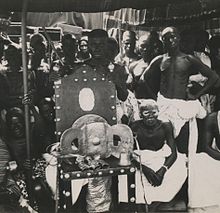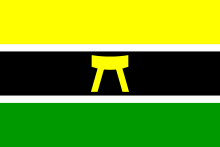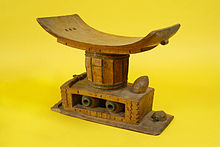Sika Dwa Kofi

- Wɔatwerɛ nsɛm wei ɛwɔ Asante kasa mu


Sika Dwa Kofi,(![]() pronounciation of "Sika Dwa Kofi" (help·info)) a potɔfoɔ frɛ no "Golden Stool" no, ɛyɛ Asantefoɔ ahenie ne wɔn Adehyedie dwa. Na ɛyɛ ahyɛnsodeɛ a ɛkyerɛ tumi a ɛwɔ Asanteman.[1] Okunini Ɔkɔmfo Anokye, na na ɔyɛ Ɔkɔmfo Panyin, na ɔsan ɛka atitire baanu a wɔtee Asanteman Nkabomkuo no. Ɔno na ɔfrɛɛ Sika Dwa no efirii wiem ma no besii Asantehene a ɔdikan, Osei Tutu ɛserɛ so.[2] Saa berɛ no mu no, na ahenwa bi saa ɛdan amammerɛ ahyɛnso soronko a ɛfa ɔhene biara amamuo ho, nanso dodoɔ no ara gyidi sɛ Sika Dwa Kofi ɛyɛ ahyɛnso bi a na Asantefoɔ - wɔn a wɔte aseɛ, wɔn a wawu ɛne wɔn a afei na yɛrebɛwo wɔn nyinaa homhom ɛwɔ mu.[3]
pronounciation of "Sika Dwa Kofi" (help·info)) a potɔfoɔ frɛ no "Golden Stool" no, ɛyɛ Asantefoɔ ahenie ne wɔn Adehyedie dwa. Na ɛyɛ ahyɛnsodeɛ a ɛkyerɛ tumi a ɛwɔ Asanteman.[1] Okunini Ɔkɔmfo Anokye, na na ɔyɛ Ɔkɔmfo Panyin, na ɔsan ɛka atitire baanu a wɔtee Asanteman Nkabomkuo no. Ɔno na ɔfrɛɛ Sika Dwa no efirii wiem ma no besii Asantehene a ɔdikan, Osei Tutu ɛserɛ so.[2] Saa berɛ no mu no, na ahenwa bi saa ɛdan amammerɛ ahyɛnso soronko a ɛfa ɔhene biara amamuo ho, nanso dodoɔ no ara gyidi sɛ Sika Dwa Kofi ɛyɛ ahyɛnso bi a na Asantefoɔ - wɔn a wɔte aseɛ, wɔn a wawu ɛne wɔn a afei na yɛrebɛwo wɔn nyinaa homhom ɛwɔ mu.[3]
Sɛnkyerɛnne ne Nyankomade
[sesa]Dodoɔ nteaseɛ kyerɛ sɛ, ahenwa biara yɛ ne wura kra, na sɛ ɔnte so a, yɛde si ban ho ma akra afoforɔ a wɔretwam tena so ɛgye wɔn ahome. Sika Dwa Kofi yɛ adehyedie ahenwa a enni ho kwan sɛ ɛka fam dabiara da. Ne saa nti, wɔde si adasoɔ so.[4] Sɛ wɔresi hene a, wɔpagya no kɔ soro ɛde no sensɛn Sika Dwa no so, ɛberɛ a wɔmma neho nka.[5] Wɔpagya Sika Dwa no wɔ sumeɛ[6] ɛde kɔkyerɛAsantehene, na ɔno nko na ɔwɔ ho tumi sɛ okura Sika Dwa Kofi no mu. Sɛ yɛbɔ dwa kɛseɛ a, wɔde Sika Dwa Kofi esi Hwedɔm dwa no so, ɛde si Asantehene benkum so; na wɔde Sika Dwa no ani kyerɛ Ɔmanfoɔ no.[7]
Ntawantawa ɛwɔ Abakɔsɛmu
[sesa]Ɔko bebree[8] na asɔre ɛfa deɛ Saa ahendwa yi yɛ ne adeɛ.[9] Wɔ afe apem ahanwɔtwe ne aduokron nsia (1896) no, wɔ tuu Asantehene Prempeh 1 ɛsan sɛ na wɔ mpɛsɛ wɔbɛ hwere ɔko ne adwa no abomu. Wɔ a afe apem ahankron (1900) no, Owura Frederik Hodgson a na ɔyɛ aban mu panin wɔ Gold Coast, hyɛɛ sɛ[5] wɔmfa no ntena Sika dwa no so na ɔhyɛɛ sɛ wɔn nhwehwɛ bɛɛbia Sika dwa no wɔ. Wei hyɛɛ asradɔm bi nom abufuo a wɔfrɛɛ no Sika dwa ko, ɛnam wei so maa wɔsii Asanteman kwan wɔ ngrɛsi abrɔfo ahenie no nanso wɔbɔɔ Sika dwa no ho ban. Wɔ afe apem ahankron ne aduonu baako (1921) no, abibifoɔ bi a wɔyɛ akwan hunuu adwa no na wɔ wiaa Sika kɔkɔɔ a ɛwɔ ho no bi.[10] Ngrɛsi abrɔfo de wɔn kɔsieɛ ansa na wɔbuaa wɔn kumfɔ sɛdeɛ mmra teɛ.[10] Ngrɛsi abrɔfo dii agyenamu maa wɔtware wɔn asuo a wɔankum wɔn.[10] Ngrɛsi abrɔfo hyɛɛ bɔ sɛ wɔ ne adwa no nya twaka biom ɛnti wɔ yi firii asieɛ.[10] Wɔ afe apem ahankron ne aduasa num (1935) no, wɔde adwa no dii dwuma wɔ afahyɛ bi a wɔde hyɛɛ Osei Tutu Agyeman Prempeh II hene.[11]
Appearance and craftsmanship
[sesa]
Sika dwa tenten yɛ 46 cm, ne tɛterɛtɛ yɛ 61 cm na ɛmu dɔ kɔsi 30 cm.[12] Wɔde Sika kɔkɔɔ na adwira ho na adɔma sensɛn ho sɛ ɛbɛbɔ ɔhene no kɔkɔ wɔ bɔne bi a ɛrebɛba.[13] Nipa pii nhunuie na ɔhene, ɔhemaa, ɔhene ba barima trodoo ne afutufoɔ a wɔgye wɔn di na ɛnim bɛɛbi a wɔde asie. Wayɛ ne nsɛsoɔ ama ahenfo na wɔ Ayie ase wɔde mmoa mogya yeyɛ ho.[14] Adwa no yɛ agyinasoɔ ma Asanteman ɛnɛ ɛsan sɛ ɛkyerɛ tumi ne nnidisoɔ.[9]
Beaeɛ a menyaa mmoa firiiɛ
- ↑ [1] "African Gold-weights in the British Museum"
- ↑ [2] "How the Asantehene climaxed the 20th anniversary on the Golden Stool [PHOTOS]". www.graphic.com.gh. 2019-04-22. Retrieved 2019-05-18.
- ↑ [3] Kyerematen, A. (1969). "The Royal Stools of Ashanti". Africa: Journal of the International African Institute. 39 (1): 1–10. doi:10.2307/1157946. ISSN 0001-9720. JSTOR 1157946.
- ↑ [4] "What is the royal and sacred object of the Ashanti people?". GlobalQuiz. Retrieved 2020-02-22.
- ↑ 5.0 5.1 [5] "History of Golden Stool". www.ghanaweb.com. Retrieved 2020-02-22.
- ↑ [6] "Queen-Mother Yaa Asantewaa and the Golden Stool. | Hadithi Africa". Retrieved 2020-02-22.
- ↑ [7] "Akan Leadership Arts".
- ↑ [8] "Golden Stool of the Asante". History of International Relations. 2018-10-14. Retrieved 2020-02-22.
- ↑ 9.0 9.1 [9] "Asante Art - Artefacts - Stools". asante.neocities.org. Retrieved 2020-02-22.
- ↑ 10.0 10.1 10.2 10.3 [10] Carmichael, John (1993). African Eldorado - Gold Coast to Ghana. Gerald Duckworth & Co. Ltd. pp. 176–77. ISBN 0-7156-2387-7.
- ↑ [11] Michael T. Kaufman (March 4, 1999). "Opoku Ware II, King of Asante, Is Dead at 89". New York Times.
- ↑ [12] "How a mysterious Golden Stool is keeping the great Ashanti kingdom united". Face2Face Africa. 2018-09-20. Retrieved 2020-02-22.
- ↑ [13] Yussif, Elias (2013-07-24). The Facet of Black Culture. Trafford Publishing. ISBN 978-1-4669-8848-4.
- ↑ [14] Hadzija, Boka (November 2013). My Door is Always Open: A Memoir. Xlibris Corporation. ISBN 978-1-4836-2925-4.
